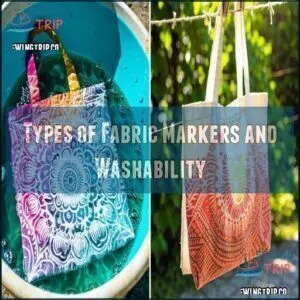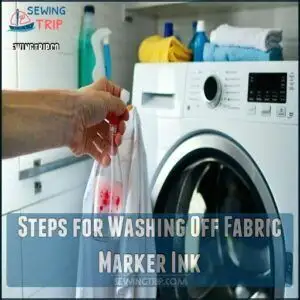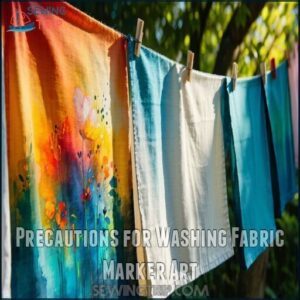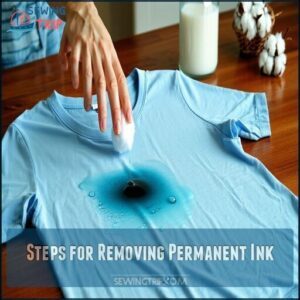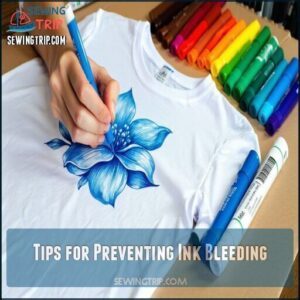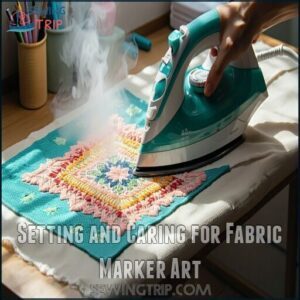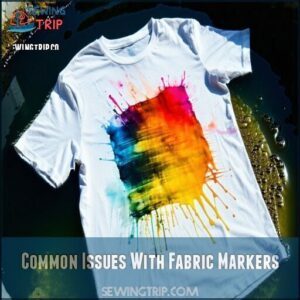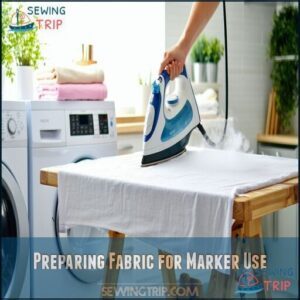This site is supported by our readers. We may earn a commission, at no cost to you, if you purchase through links.
 Yes, fabric markers can be washed, but with important caveats.
Yes, fabric markers can be washed, but with important caveats.
Permanent fabric markers are designed to withstand multiple washes when properly heat-set—just iron your creation for 3-5 minutes or tumble dry on high heat.
Washable fabric markers, however, are meant to disappear in the wash. Your fabric type matters too; cotton holds ink better than synthetic materials.
Always wash your marked items inside-out in cold water using mild detergent to prevent fading. Like that favorite band t-shirt that’s seen better days, even permanent markers will gradually fade over time.
The right pre-treatment techniques can make the difference between art that lasts and designs that vanish.
Table Of Contents
- Key Takeaways
- Fabric Marker Basics
- Can Fabric Markers Be Washed
- Types of Fabric Markers and Washability
- How to Wash Fabric Marker Art
- Removing Fabric Marker Ink
- Setting and Caring for Fabric Marker Art
- Common Issues With Fabric Markers
- Choosing The Right Fabric Markers
- Preparing Fabric for Marker Use
- Frequently Asked Questions (FAQs)
- Conclusion
Key Takeaways
- You’ll need to heat-set permanent fabric markers by ironing for 3-5 minutes or tumble drying on high heat to ensure they withstand multiple washes.
- Your fabric type matters significantly—cotton holds ink better than synthetic materials, so choose your fabric wisely for longer-lasting designs.
- You should always wash your marked items inside-out in cold water with mild detergent, avoiding fabric softeners which break down the dyes.
- You can’t expect perfect permanence—even properly heat-set markers will gradually fade over time, with blacks and blues typically fading first after 10-15 washes.
Fabric Marker Basics
You’ll find fabric markers in both permanent and washable varieties, with each type containing specialized inks designed for different textile projects.
They’re available with various tip sizes, ink formulations, and color options that allow you to create everything from detailed artwork to bold statements on your fabric surfaces.
What Are Fabric Markers
Fabric markers are specialized ink-filled wonders designed specifically for creating lasting designs on textile surfaces.
They contain unique Marker Composition that bonds with fabric fibers, unlike regular markers that merely sit on the surface.
You’ll find these artistic tools come in various Ink Properties, from vibrant permanent fabric markers to kid-friendly washable fabric markers.
- Application Surfaces include cotton, denim, canvas, and polyester blends
- Color Range spans from basic primaries to metallic, neon, and pastel shades
- Marker Safety ratings vary, with many brands offering non-toxic options
- Fabric marker permanence depends on heat-setting and proper application techniques
These versatile tools bridge the gap between drawing and textile design, making custom fabric creations accessible to everyone.
Types of Fabric Markers
Now that you understand what fabric markers are, let’s explore the variety of options available for your creative projects.
When choosing fabric marker types, you’ll encounter different levels of fabric marker permanence:
- Permanent fabric markers: These contain special dyes that bond with fabric fibers, creating lasting designs that withstand multiple wash cycles.
- Washable fabric markers: Ideal for kids’ projects or temporary designs, these markers contain water-soluble ink that fades gradually with washing.
- Dual-tip markers: Offering both fine and broad tips on opposite ends, these provide versatility for detailed work and filling larger areas.
The color range spans from basic primaries to vibrant neons, with some requiring heat setting for durability.
You can find a variety of permanent marking solutions online.
Your choice should match both your fabric type and project goals—consider whether you need specialized applications like markers formulated specifically for denim, silk, or even shoes.
Key Characteristics of Fabric Markers
Now that you’re familiar with marker types, let’s explore what makes them uniquely suited for fabric projects.
The key characteristics determine how well your creations will hold up over time.
| Characteristic | Description | Impact on Use |
|---|---|---|
| Ink Composition | Water-based vs. alcohol-based | Affects fabric marker washability |
| Tip Variety | Fine, brush, chisel points | Determines detail level in designs |
| Permanence Levels | Washable to heat-set formulas | Controls longevity of your artwork |
Your fabric’s type also influences compatibility—cotton absorbs color differently than polyester.
Remember, permanent fabric markers require heat setting for best results.
Can Fabric Markers Be Washed

Now that you understand the basics, let’s tackle the million-dollar question: can fabric markers truly survive the washing machine?
Yes, most fabric markers can be washed—with proper preparation. Your design’s wash resistance depends entirely on the marker type and how you set it.
- Think of heat-setting as "baking" your artwork into the fabric—it’s the secret ingredient between a one-wash wonder and a lasting masterpiece.
Permanent markers offer excellent ink permanence when heat-set correctly, while washable varieties may show color fading after several cycles. Always check the packaging for specific fabric marker washing instructions.
To maintain fabric integrity, consider spot cleaning methods to avoid harsh washing. Avoid fabric softeners when washing your creations—they can break down the dyes.
For best results, use cold water, gentle cycles, and turn garments inside-out to minimize friction. With proper fabric marker washing techniques, your artistic expressions can remain vibrant for years.
Types of Fabric Markers and Washability
You’ll need to understand the different fabric marker types to predict how your designs will hold up in the wash.
Permanent markers contain dyes that bond with fabric fibers, while washable versions offer temporary color that fades with laundering.
Permanent Markers and Ink Adhesion
Now let’s explore why permanent markers stay put on fabric. The secret lies in the chemical bonds formed between oil-based ink and fabric fibers.
When you apply permanent fabric markers to textiles, their non-polar ink compounds create strong adhesion that resists water. Quality marker brands contain special polymers that penetrate deeper into fabric weaves.
For maximum ink permanence, heat setting is essential—it activates these polymers, forming lasting bonds at the molecular level. Unlike washable options, permanent markers contain ink that maintains fabric marker longevity through multiple washes.
Consider using specific oil-based options for best results. The oil-based formulation creates a waterproof barrier that preserves your design’s vibrancy even after repeated laundering.
Non-Permanent Markers and Dye Binding
Non-permanent markers’ chemistry revolves around special dye binding that creates semi-permanent designs on your fabric.
When you use washable fabric markers, the water-soluble inks form temporary bonds with fabric fibers that release with washing. Unlike permanent markers, these markers strike a perfect balance between artistic expression and practicality.
- Washable markers contain specialized polymers that prevent complete fabric adhesion
- Water-soluble inks allow for fabric marker removal with proper washing techniques
- Dye binding is strong enough for multiple gentle washes on cotton and canvas
- Fabric safety is guaranteed through non-toxic formulations perfect for children’s projects
Test fabric marker washability on a hidden area first—your temporary designs will maintain vibrancy while giving you creative freedom to change your mind later. You can find various marker options online.
Factors Affecting Ink Removal
Building on what we’ve seen about non-permanent markers, several factors determine how easily fabric marker ink can be removed during washing.
Fabric marker washability depends primarily on:
- Fabric type – natural fibers like cotton release ink more readily than synthetic materials
- Ink composition – water-based inks wash out more easily than alcohol-based formulations
- Washing methods – hot water and harsh detergents accelerate ink removal
- Stain age – fresh marks are easier to remove than set-in stains
- Pre-treatment effects – stain removers can break down even permanent inks
The relationship between your fabric and marker type creates a chemical bond that varies in strength. For example, washing fabric art created with permanent markers on polyester might require specialized solvents, while washable markers on cotton will fade with standard laundering.
When attempting fabric marker removal, always test your washing fabric method on an inconspicuous area first, considering the fabric type and stain age to ensure the best results for removing set-in stains with stain removers and harsh detergents.
How to Wash Fabric Marker Art
You’ll need to wash your fabric marker creations with specific techniques to maintain their vibrancy and prevent bleeding.
Turn your garments inside out and use cold water with mild detergent to protect your artistic handiwork from fading.
Steps for Washing Off Fabric Marker Ink
Understanding how fabric markers work helps us now tackle proper washing methods.
When you need to remove fabric marker ink, your approach depends on whether it’s intentional removal or accidental staining.
Here’s how to handle washing off fabric marker ink effectively:
| Method | Best For | Success Rate |
|---|---|---|
| Rubbing alcohol | Fresh stains | High |
| Milk soak | Set-in ink | Medium |
| Hairspray | Small spots | Medium-high |
| Stain remover | Multiple stains | Variable |
| Immediate action | Any stain | Highest |
The key to successful removal is taking immediate action, as this yields the highest success rate, especially for fresh stains or small spots.
Alternative Methods for Ink Removal
When standard washing doesn’t remove fabric marker stains, try these proven alternatives:
- Rubbing alcohol method: Apply directly to fresh stains with a cotton ball for immediate action on oil-based markers.
- Hairspray technique: Spray alcohol-based hairspray on the stain, let sit for 5 minutes, then blot.
- Milk soak remedy: Submerge stained area overnight to naturally lift ink.
- Acetone application: Use sparingly on synthetic fabrics before running through a washing machine.
For glass projects, consider using a clear acrylic sealer to protect your designs.
Quick response guarantees better mistake correction!
Precautions for Washing Fabric Marker Art
Every fabric marker masterpiece requires specific washing precautions to maintain its vibrancy. Always start with pre-wash testing on an inconspicuous area to check color fastness before laundering the entire piece.
Use cold water exclusively with gentle detergents specifically formulated for delicate items—harsh chemicals and bleach are enemies to your artwork. Carefully check fabric care labels for specific washing guidelines before proceeding.
For ideal bleed prevention, turn your creation inside-out before washing and use the gentlest cycle. Never wring or twist fabric marker designs, as this damages ink adhesion. Choose air drying methods over machine drying to prevent color fading.
These fabric marker washing tips guarantee your designs remain vibrant through multiple launderings, preserving your creative expression for years to come.
Removing Fabric Marker Ink
You’ll need the right tools and techniques to remove unwanted fabric marker ink from your projects.
Whether you’re fixing a mistake or repurposing a fabric item, understanding the proper removal methods based on ink type will save your materials from permanent damage.
Steps for Removing Permanent Ink
Permanent marker’s stubborn stains don’t have to ruin your favorite fabrics.
Lay the stained item flat with the mark facing up, then saturate a cotton ball with rubbing alcohol. Dab a hidden area first to test for discoloration.
Using circular motions, gently work the alcohol application into the stain, replacing cotton balls as they absorb ink. For stubborn stains, try the hairspray method or even a milk soak overnight.
Always follow with a washing machine cycle using cold water and mild detergent. Remember: immediate action dramatically increases your chances of successful stain removal.
Steps for Removing Washable Ink
The clock is ticking when removing washable ink from fabric.
Begin by blotting—never rubbing—the stain to prevent spreading. Apply cold water with mild detergent directly to fabric marker stains, working from the outside in.
For stubborn marks, dab with alcohol content solutions or try a milk soak overnight. Always test any fabric marker washing methods on an inconspicuous area first.
After treatment, run the item through your washing machine on a gentle cycle.
Immediate action is your best ally when fixing fabric marker mistakes. Remember to air dry completely—heat can permanently set remaining pigments, and this is a critical step.
Tips for Preventing Ink Bleeding
Five simple techniques will keep your fabric marker designs crisp and prevent frustrating bleeding issues.
- Choose the right fabric – Tightly woven materials like cotton prevent ink migration during washing
- Apply gentle marker pressure – Heavy application forces ink deeper, causing bleeding when washed
- Master the blotting technique – Immediately press paper towels against excess ink to absorb before it spreads
- Use strategic layering methods – Allow each color to dry completely before adding adjacent hues
Stabilizing fabric with cardboard underneath while working provides a firm surface that minimizes bleeding.
For stubborn projects, heat setting between layers offers extra protection against washing disasters.
Setting and Caring for Fabric Marker Art
You’ll need to properly set and care for your fabric marker creations to guarantee they stand the test of time and repeated washing.
After your artistic vision comes to life on fabric, follow specific heat-setting techniques and gentle washing methods to preserve those vibrant colors for years to come, ensuring they remain vibrant.
Heat Setting Techniques for Ink Fixation
Properly heat setting your fabric marker designs substantially extends their lifespan.
Set your iron to the appropriate temperature for your fabric type—cotton requires 160°C-180°C, while synthetics need 115°C-130°C.
Place parchment paper over your design and press firmly for 3-5 minutes with no steam.
For professional results, a heat press provides consistent temperature and pressure.
Alternatively, use a heat gun held 4-5 inches away, moving constantly for 1-2 minutes.
Always test on a small area first to prevent scorching your fabric marker art and ensure the best outcome.
Washing Fabric Marker Art With Care
After heat setting your fabric marker art, wash it with the utmost care to maintain those vibrant designs.
Turn garments inside out, use cold water, and select a gentle cycle with mild detergent specifically formulated for colored items.
For ideal fabric marker washing results:
- Your beloved creations deserve protection from harsh chemicals that could strip away their personality
- Saying no to bleach means saying yes to long-lasting artwork that tells your story
- Each gentle machine cycle preserves the memories etched into your fabric
Always air dry to prevent color fading.
Storage and Preservation Tips
To guarantee your fabric marker designs last for years, store them in acid-free containers away from direct sunlight exposure.
Temperature control is vital—keep items in cool, dry areas where humidity effects won’t fade colors.
When folding decorated items, use proper techniques that prevent creasing along design lines.
Don’t stack heavy items on your fabric art, and handle with clean hands to prevent oils from transferring.
These simple fabric marker preservation techniques protect your creative work.
Common Issues With Fabric Markers
You’ll likely encounter bleeding and fading issues when washing your fabric marker creations, especially if you haven’t properly heat-set the designs.
Colors can migrate into surrounding fabric or gradually lose their vibrancy over time, particularly with repeated washing and exposure to harsh detergents, which can cause bleeding.
Bleeding and Ink Migration After Washing
Now that you’ve mastered setting fabric marker art, let’s tackle a common frustration: bleeding and ink migration.
Dye migration often occurs when polyester dyes turn gaseous during washing, invading your careful designs.
Here’s how to protect your fabric art:
- Test markers on fabric scraps before starting your main project
- Apply low-bleed inks specifically designed for your fabric type
- Avoid high heat during washing which re-energizes dyes and causes bleeding
- Use dye stabilizing solutions on neighboring areas to prevent color transfer
When washing, remember that synthetic fibers resist bleach, while natural fibers may not.
Fading and Color Loss Over Time
Time and washing cycles gradually diminish your fabric marker designs, regardless of their "permanent" status.
Time gradually fades even "permanent" fabric marker designs, with each washing cycle stealing a bit of their vibrant life.
Color fastness varies substantially based on several factors:
| Factor | Impact on Fabric Marker Colors |
|---|---|
| Sunlight Exposure | Accelerates fading, especially with vibrant colors |
| Fabric Type | Cotton fades faster than polyester blends |
| Ink Quality | Premium markers offer better wash resistance |
| Washing Machine | Hot cycles increase color loss substantially |
| Color Fastness | Blacks and blues typically fade first |
You’ll notice color vibrancy diminishing after 10-15 washes, even with proper care. Black markers may develop a greenish tint as they fade.
For maximum design longevity, store your fabric art away from direct light and wash inside-out using cold water.
Tips for Long-Term Durability
While colors naturally fade with time, you can preserve your fabric marker art with proper care.
To maintain your designs for years to come:
- Choose high-quality Marker Quality from trusted brands for superior pigments
- Apply proper fabric marker heat setting techniques using medium heat for 3-5 minutes
- Use gentle fabric marker washing care with cold water and mild detergent
- Store designs away from direct sunlight to prevent premature fading
Fabric Selection matters too—tightly woven cotton holds designs better than loose knits.
With these Storage Solutions and Washing Techniques, your fabric marker creations will maintain their vibrancy through countless washes.
Choosing The Right Fabric Markers
You’ll need to match your fabric markers to both your material type and design goals for the best washability results.
Consider factors like tip size, ink formulation, and permanence rating to guarantee your creative projects withstand laundering without disappointment.
Considering Fabric Type and Project Requirements
Your fabric choice can make or break your marker project’s success. Different fabric types require specific markers for maximum results and project durability.
| Fabric Type | Marker Compatibility | Care Requirements |
|---|---|---|
| Cotton | Washable & permanent | Machine washable |
| Polyester | Permanent only | Gentle cycle |
| Canvas | Opaque, bold markers | Spot clean |
Cotton works beautifully with most fabric markers, delivering vibrant color that holds up well in the washing machine. Polyester needs permanent fabric markers to prevent fading. Canvas provides an excellent base for detailed designs with high color vibrancy.
Always test markers on fabric scraps first—this simple step guarantees your design complexity matches your materials and saves you from disappointing results. It is crucial to follow this step to ensure the success of your project, as it allows you to verify the marker compatibility before proceeding.
Selecting Tip Size for Desired Design Elements
Now that you’ve matched your fabric to your project, let’s focus on selecting the right tip size for your design elements.
Choosing the proper fabric marker tip substantially impacts your final results.
Here’s what different tips can do for your designs:
- Fine Tip markers create precise lines and intricate details in small spaces
- Broad Tip options fill large areas quickly with consistent color coverage
- Chisel Tips deliver both thin and thick lines with a single marker
- Brush Tips produce flowing, painterly effects for artistic designs
- Bullet Tips offer a balance between detail work and filling capabilities
Preparing Fabric for Marker Use
You’ll need to properly prepare your fabric before applying markers to guarantee lasting, vibrant designs that withstand washing.
Wash your fabric to remove oils and sizing agents, then iron it smooth to create the ideal surface for your marker masterpiece, ensuring vibrant designs that are long-lasting.
Importance of Pre-Washing and Ironing
The essential first step before reaching for fabric markers is proper preparation. Pre-washing removes sizing and manufacturing chemicals that can block ink adhesion, while preventing future shrinkage that could distort your design. Pre-washing also stabilizes the fabric for easier handling.
- Smooth surface creation through careful ironing guarantees your markers glide effortlessly
- Heat setting after marking helps lock colors for washing machine durability
- Fabric preparation substantially enhances color vibrancy and longevity
This foundation work guarantees your creative designs will maintain their appeal through multiple washes, ensuring the best results.
Applying Fabric Medium for Better Adhesion
Now that your fabric is pressed smooth, it’s time to apply fabric medium for better ink adhesion.
This specialized liquid additive improves how fabric markers bond to fibers, increasing durability by up to 40%.
Apply a thin, even layer across your material and allow it to dry completely before starting your design.
The medium alters paint viscosity and finish, particularly helpful when working with oily fabrics that might otherwise repel ink.
Factors Affecting Ink Longevity and Fading
Now that your fabric is properly prepped with medium, let’s explore what impacts your design’s staying power.
Five key factors affect fabric marker design longevity: ink composition, fabric type, washing techniques, light exposure, and heat setting.
Cotton fabrics retain vibrant colors longer than synthetics.
Washing in cold water reduces fading, and UV rays accelerate color loss.
Proper heat setting locks in pigments, and machine washing frequency directly impacts durability, making cold water a crucial factor.
Recommendations for Preserving Marker Designs
Preserving your masterpieces requires strategic care for lasting vibrancy.
Follow these proven preservation techniques:
- Apply heat-setting methods by pressing with an iron on medium heat for 3-5 minutes, ensuring ink bonds permanently with fabric fibers.
- Implement gentle washing techniques by turning garments inside-out and using cold water cycles with mild detergent.
- Shield designs from harsh elements by avoiding bleach, fabric softeners, and direct sunlight exposure that accelerate fading.
With proper fabric marker care, your creative designs will maintain their brilliance through countless washes.
General Care and Storage Tips
To protect your fabric marker designs, proper care and storage are absolutely essential. With these simple practices, you’ll extend both marker shelf life and artwork longevity:
- Store projects in acid-free containers away from direct sunlight exposure to prevent color fading
- Maintain humidity control by keeping fabric art in cool, dry environments between 60-75°F
- Cap markers immediately after use to prevent tip drying—store horizontally for ideal ink flow
- Handle finished pieces with clean hands to avoid transferring oils that break down dyes
Temperature effects can dramatically impact your designs over time. When washing fabric marker creations, always follow manufacturer’s care instructions—cold water and gentle cycles will keep your artistic expression vibrant for years. Proper care is crucial to preserve the integrity of your artwork and ensure it remains a beautiful expression of your creativity.
Frequently Asked Questions (FAQs)
Should I wash my fabric after using markers?
Yes, you should wait 24-72 hours after using fabric markers.
Then heat-set the design with an iron.
Afterward, wash in cold water with mild detergent and air dry to preserve your artwork’s vibrancy.
How do you wash fabric marker art?
Like treasured memories preserved in fabric, your marker art needs gentle care.
Turn garments inside out, wash with cold water and mild detergent, then air dry to maintain the vibrant colors.
How do you wash a marker?
To clean a marker, remove the cap, rinse the tip under warm water, and gently dab with a cloth.
For dried markers, soak the tip in rubbing alcohol, then rinse thoroughly.
Can you use permanent markers on fabric?
You can definitely use permanent markers on fabric.
They’ll stick around after washing, unlike regular markers.
For best results, heat-set your design with an iron to make it more durable and long-lasting.
How do you keep a marker from fading?
Worried about fading designs? Heat-set your fabric markers by ironing the reverse side for 3-5 minutes on medium heat, then wash in cold water and air dry to maintain vibrancy.
How to clean fabric with Sharpie marker?
To remove Sharpie from fabric, apply rubbing alcohol with a cotton ball and blot. Don’t rub. For stubborn stains, try hairspray or milk. Launder immediately after stain treatment.
Are fabric markers machine washable?
Some fabric markers are machine washable, while others aren’t.
It depends on the type – permanent markers stay put through washing, but washable markers will fade.
Always check the product label for specific care instructions.
Are fabric markers permanent on fabric?
Some fabric markers are permanent while others are washable.
You’ll find permanent markers create lasting designs through multiple washes, while washable markers will fade.
Check the label to confirm the type you’re using.
What fabric markers won’t wash out?
Permanent fabric markers with acrylic or alcohol-based ink won’t wash out.
Look for brands like Tulip, Marvy Uchida, and Zig Textile that specifically state "permanent" on their packaging for long-lasting designs.
Does a fabric marker wash out?
You’ll be in a pickle if you don’t check the label.
Some fabric markers are specifically designed to wash out, while permanent fabric markers won’t.
It depends entirely on the type you’re using.
Conclusion
Armed with these tips, you now understand that fabric markers can be washed—with proper precautions.
Your artistic creations don’t have to disappear like messages on ancient smoke signals.
Remember that permanent markers require heat-setting, while washable ones are designed to fade.
Choose the right marker for your project, prepare your fabric correctly, and follow proper care instructions.
With these techniques, your fabric art will maintain its vibrant charm through many wash cycles to come.
- https://www.reddit.com/r/sewing/comments/16pmz19/washable_fabric_pen_does_not_wash_out/
- https://tulipcolor.com/blogs/faqs/can-you-wash-off-fabric-marker
- https://www.amazon.co.uk/Hemline-Fabric-Marker-Wipe-Wash/dp/B003KBN4ZY
- https://northshorecrafts.com/sharpie-permanent-marker-on-fabric/
- https://www.thespruce.com/will-permanent-marker-stay-on-fabric-2146210


